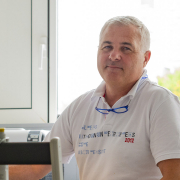
The CYTOMER technical platform aims to study the characteristics of marine organism cells. Determining these characteristics enables the phenotyping of cell populations and the assessment of numerous cellular functions.
The characteristics studied on the CYTOMER platform can be descriptive (size, complexity, etc.) or functional, using natural fluorescence levels (autofluorescence) or fluorescence levels linked to the incorporation of fluorescent probes. For example, it is possible to study the relative volume/size and morphological complexity of cells, nucleic acid content, intracellular pigments (chlorophyll, phycoerythrin, etc.), mitochondrial membrane potential, lipid content, cell viability, signs of apoptosis, intracellular oxidative activity, phagocytosis, multi-xenobiotic resistance, etc.
A wide variety of cells and models are studied in the laboratory: mollusc haemocytes (clams, oysters, clams, abalone, cockles, etc.), oyster spermatozoa and oocytes, marine phytoplankton cells, both toxic and non-toxic, marine bacteria, marine viruses, fish blood cells, etc.
The CYTOMER platform offers four types of analysis, which often complement each other: flow cytometry, epifluorescence microscopy, flow imaging and scanning electron microscopy.
Flow cytometry is a technique for analysing cells suspended in a liquid flow. The cells are excited by a laser beam and scatter and/or refract light signals. These signals are quantified and reveal the optical characteristics of the cells.
Flow cytometry is a qualitative and quantitative technique that can analyse up to 10,000 events per second. Depending on the equipment, it can also be used to sort and preserve the cells of interest, either in tubes or in microplates (clones).
Epifluorescence microscopy is a microscopic observation technique that uses either the natural fluorescence of objects or fluorescence linked to the addition of specific probes. It can be used to visualise a structure, a compound and/or an activity.
Complemented by pseudo-confocal technologies (spinning disk) and appropriate software, epifluorescence microscopy can be used to image objects in three dimensions.
Flow imaging is an imaging technique for objects measuring from a few microns to 2 mm and transported in a liquid flow.
Image acquisition can be triggered by the presence of a fluorescent signal. Image analysis software is used to select objects of interest and measure a wide range of descriptive parameters (diameter, perimeter, volume, circularity, concentrations, etc.).
Scanning Electron Microscopy (SEM) enables the surface of various objects to be imaged at high resolution and magnification (x100,000) using the principle of electron-matter interactions. A metalliser (gold) is used to prepare objects with little or no conductivity.
View the list of Cytomer platform equipment
[embed]https://www.youtube.com/watch?v=1DrKAJdKQAg&t=7s[/embed]
[av_slideshow img_copyright='left' size='no scaling' control_layout='av-control-default' slider_navigation='av-navigate-arrows av-navigate-dots' nav_visibility_desktop='' nav_arrow_color='' nav_arrow_bg_color='' nav_dots_color='' nav_dot_active_color='' img_copyright_font='' av-desktop-font-img_copyright_font='' av-medium-font-img_copyright_font='' av-small-font-img_copyright_font='' av-mini-font-img_copyright_font='' img_copyright_color='white' img_copyright_bg='black' animation='slide' transition_speed='' autoplay='true' interval='5' img_scale='' img_scale_end='10' img_scale_direction='' img_scale_duration='3' img_scale_opacity='1' conditional_play='' img_scrset='' lazy_loading='disabled' alb_description='' id='' custom_class='easy-slider-text' template_class='' av_uid='av-ug0rdpg' sc_version='1.0']
[av_slide id='186891' av_uid='av-oga3rac'][/av_slide]
[av_slide id='185114' av_uid='av-25i1nz8'][/av_slide]
[av_slide id='186893' av_uid='av-gxj8euc'][/av_slide]
[av_slide id='186895' av_uid='av-dh0nt9g'][/av_slide]
[/av_slideshow]



 MAERL
Scroll to top
MAERL
Scroll to top